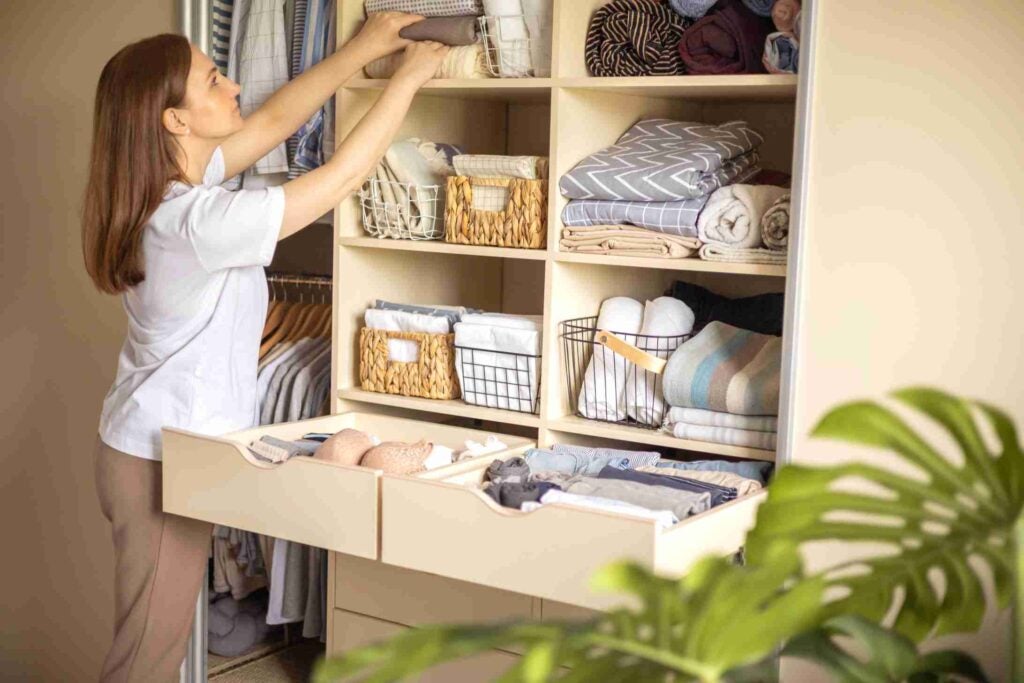-
Storage Hacks: 10 Important Tips When Living Alone for the First Time

Living alone for the first time is exhilarating and a tad nerve-wracking. It is your space, so you set the rules, but you must also plan every meal and keep the place clean all by yourself. With a little planning and practicality, you will make solo living a dream come true.
Here is how to navigate this new chapter with confidence.
1. Budget Like a Pro
Living alone means you are in charge of your finances, so you need a budget. First, record your monthly income and set aside 10% for a rainy day. Then, add up fixed expenses like rent, utilities, and insurance. From there, allocate a reasonable amount for groceries, transportation, and entertainment. You can tackle your spending with fancy budgeting apps or a simple spreadsheet—just be sure to adjust it as needed.
2. Keep a Spare Key on Hand
Nothing kills the excitement of living alone faster than locking yourself out. Avoid this fate by making a copy of your house key and keeping it safe. You can ask a trusted friend, family member, or neighbor to hold onto the spare or hide it in a secure location. Keyless entry systems or smart locks are another great investment if you are prone to misplacing things.
3. Keep Things Tidy
With no one around to complain about the mess, it is tempting to let dishes pile up. But keeping your space clean makes it more enjoyable to live in, not to mention easier to maintain. Set a simple cleaning routine, like tidying up for 10 minutes a day or dedicating one day a week to deep cleaning. If things are a bit too crowded, consider renting a self-storage unit to free up some space.
4. Master the Art of Cooking for One
Surviving on takeout and instant noodles is fun at first, but your wallet and health will thank you for learning to cook. Start with simple recipes, like stir-fry, pasta dishes, and one-pan meals. To save time and money, try meal prepping, which involves cooking in large batches and freezing portions for easy meals later.
5. Embrace the Solitude, but Stay Social
Living alone means a lot of quiet moments. It might feel weird at first, but it is an opportunity to focus on yourself. Whether you enjoy reading, binge-watching your favorite shows, or dancing in your pajamas, take advantage of having space to do whatever makes you happy. Of course, do not resort to isolating yourself. Regularly hang out with friends, call family members, or join a local club to maintain a healthy social life.
6. Get to Know Your Neighbors
Introduce yourself to your neighbors when you move in, even if it is just a simple hello. Knowing your neighbors comes in handy when you need to borrow an egg, have someone accept a package, or water your plants while you are out of town. Who knows—you might even develop a lasting friendship.
7. Stock Up on Essentials
There is nothing worse than realizing you are out of toilet paper at midnight. Avoid the panic by keeping basic household supplies stocked. This means adding things to your shopping list before they run out completely.
8. Prioritize Safety
Make a habit of locking the doors and windows whether you are at home or away and consider installing a video doorbell. If you live in an apartment, get familiar with the building’s security measures and escape routes. In case of an emergency, keep contact information for local emergency services, a trusted neighbor, and a dependable friend or family member on hand.
9. Manage Maintenance
When something breaks, there is no roommate to call for help—it is on you now. Learn a few basic home repairs, like unclogging a drain, plunging a toilet, and resetting a tripped breaker. Stock a basic tool kit with essentials like a hammer, screwdriver, and duct tape. As for the bigger stuff, make sure you have your landlord’s number or a handyman you can call.
10. Make Moving Easier with Packing and Moving Services
Living on your own is exciting, but have you thought about how you will get there? Save time and stress by hiring a professional packing and moving company to manage the heavy lifting. You might also benefit from putting things in storage temporarily while you figure out your living situation.
How Independence Storage Simplifies Your Move
Are you moving into your first solo home soon? If you need extra space, turn to Independence Storage. We provide clean, secure storage units to make your transition go smoothly. Our ground-level drive-up units are easily accessible, and our affordable pricing packages deliver what you need without unnecessary costs. We place no limits on your time with us, so rent your unit for as short or as long as you need—we will prorate any unused rent after the first month. Check out our facility in Mountain View, CA, or reserve a unit online today!
-
Storage Hacks: Tips to Declutter and Organize Your Home

Are you tired of tripping over toys in the living room or rummaging through cluttered kitchen cabinets? Whether you are preparing to move or simply refreshing your space, an organized home makes life easier. With a few smart storage hacks, you can transform chaos into calm. All you need to do is tackle the clutter one room at a time.
Check below Storage Tips for your Home:
Prepare to Declutter
Before jumping in, set yourself up for success with these simple tips:
- Identify the areas in your home that need the most attention and set achievable goals to avoid becoming overwhelmed.
- Remove everything from a space before reorganizing. Create three piles as you go—keep, sell/donate, and store. A storage unit could be ideal for keepsakes or valuables you want to hold onto but don’t have room for at home.
- Measure shelves, drawers, and cabinets before buying storage solutions to ensure a good fit.
- Choose storage options that suit your needs and lifestyle. Options include stackable bins, drawer dividers, fabric totes, over-the-door organizers, and much more.
Once you have completed these steps, you are ready to tackle each room with confidence.
Organize the Kitchen
A well-organized kitchen makes cooking more enjoyable. The key is to keep essentials accessible while reducing clutter:
- Transfer pantry staples like flour, sugar, cereal, and pasta into clear, labeled containers. This keeps food fresh longer and makes it easier to see what you have.
- Install shelves, hanging racks, or pegboards to store pots, pans, and utensils.
- Store spices, cutting boards, or plastic wrap in cabinet door organizers.
- Arrange related items together to keep everything within easy reach. Stackable shelf risers maximize cabinet space, while lazy Susans make hard-to-reach corners more accessible.
Make the Living Room More Relaxing
Your living room should be a place to unwind. If clutter has taken over, tidy up with these tips:
- Clear off the coffee table, TV stand, and bookshelves. Place decorative boxes or baskets on them to store remote controls, magazines, and accessories.
- Choose multi-purpose furniture like storage ottomans, coffee tables with drawers, and end tables with shelves to hide clutter.
Boost Bathroom Storage
Bathrooms tend to accumulate clutter quickly, so smart storage solutions are essential:
- Assess the medicine cabinet and toss any expired meds or beauty products.
- Store everyday essentials in labeled bins under the sink so you can find them easily.
- Add shower storage with a hanging shower caddy or corner shelves.
- Install towel hooks or racks to keep them off the floor.
- Store extra toiletries in over-the-door organizers.
Declutter the Bedroom
A cluttered bedroom makes it hard to sleep well. Here is how to maximize storage while keeping things cozy:
- Sort your clothes by category and be honest about what you actually wear. If you have not worn something in a year, donate it.
- Use under-bed storage to hold seasonal clothes, shoes, or extra linens.
- Simplify the nightstand, removing everything except the essentials like a lamp, a book, and your phone charger.
Rearrange the Home Office
A clutter-free workspace boosts productivity and reduces stress. Here is how to organize your home office.
- Declutter your desk. Place everything besides your laptop, a notebook, and a few pens in drawers or labeled bins.
- Manage cords and cables with cable clips, zip ties, or a cord organizer.
- Implement a paper filing system using labeled folders or a filing cabinet. If possible, go digital to reduce paper clutter.
Get the Garage in Order
Garages are a catch-all for everything from holiday decorations to sporting equipment. A little organization goes a long way:
- Install pegboards, hooks, or shelving units to keep tools, bikes, and gardening supplies off the floor.
- Choose clear, labeled bins for seasonal decorations, camping gear, and miscellaneous items to easily see what’s inside.
- Store like items together so it’s easier to find what you need without sifting through piles of stuff.
Increase Functionality in the Laundry Room
An organized laundry room makes this chore a little less tedious:
- Use separate hampers for whites, colors, and delicate to make laundry day more efficient.
- Create a folding station at a small table or wall-mounted drop-down shelf to fold clothes right out of the dryer.
- Store detergent, stain remover, and dryer sheets on open shelves or in labeled bins. If space is tight, try a rolling cart stored near your washer and dryer.
Simplify with Independence Storage
At Independence Storage in Mountain View, CA, we know that decluttering can feel overwhelming. Whether you’re downsizing, moving, or simply making more space in your current home, our clean, secure, and accessible storage units fit your needs. We offer short- and long-term storage with flexible options and no minimum stay required. Every unit is at ground level for easy drive-up access, and we keep everything in top condition. Take the stress out of decluttering—reserve a storage unit today or contact us to learn more.
-
The Best Move-in Checklist for Couples

Moving in together is a thrilling milestone in any relationship. It is the start of a new chapter filled with shared experiences, late-night talks—and debates over the correct way to load the dishwasher. To make this transition as smooth as possible, we have compiled this move-in checklist for couples. Use it to help you organize the logistics of the move and communicate openly with your partner about this big life change.
Move In Checklists for Couples to Focus:
-
Talk About Finances
- Money can be a touchy subject, but discussing finances upfront is crucial when moving in together. Start by creating a joint budget that outlines income, expenses, and saving goals. Decide how you will split expenses, whether that’s 50/50 or proportional to income. Then, set up a joint emergency fund as a safety net for unexpected expenses.
-
Decide Where to Live
-
Declutter
-
Plan the Big Move
-
Merge Your Styles
-
Divide Household Chores
-
Establish House Rules
-
Discuss Future Plans
-
Celebrate Your New Home
The goal is to find a space that feels like home for both of you. The first decision is whether you’ll move into one partner’s current residence or start fresh in a new place. Location matters, too—factor in commute times and proximity to family and friends. Also, discuss what you find important in a neighborhood, whether it’s walkability, safety, or nearby restaurants and parks.
Combining two households means double the stuff, which makes decluttering a must. Take inventory of what each of you owns especially large items like furniture and appliances. Do you really need two toasters or three sets of measuring cups? As you declutter, sort your belongings into three categories: keep, sell/donate, or store. If you have items you’re not ready to part with but don’t have space for, a storage unit is the perfect solution.
Moving day can be stressful, so plan ahead. Consider hiring packing and moving services to handle the heavy lifting, especially if you have a lot of furniture or fragile items. Pack strategically by labeling boxes clearly and grouping items by room. Do not forget to pack an essentials box with the necessities you’ll need right away, like toiletries, a change of clothes, and basic kitchen supplies.
Moving in together requires agreeing, or at least compromising, on home decor decisions. If one of you loves modern minimalism and the other prefers rustic cabin vibes, you have got some work to do. Discuss your preferences to see where your tastes overlap. Shop for furniture and decor together and bring home pieces that reflect both of you. If certain beloved items do not fit the new aesthetic, get creative—maybe that quirky chair can go in a reading nook instead of the living room.
Cleaning the bathroom isn’t glamorous, but someone has to do it. Before resentment builds over dirty dishes, create a chore plan that works for both of you. Some couples prefer a rotating schedule, while others divide tasks based on personal strengths. If you love cooking and your partner does not mind washing dishes, that’s a natural fit.
Every household runs on unspoken rules—why not talk about them to nip disagreements in the bud? Discuss guest policies, including how often you are comfortable having visitors over. If one of you is an early bird and the other is a night owl, set quiet hours to make sure you are both getting the rest you need. Also, be open about pet peeves. From leaving shoes by the door to never replacing the toilet paper, getting the little things out in the open prevents arguments later.
While it’s great to live in the moment, knowing what you each envision for the future ensures you’re on the same page. Talk about career aspirations and whether relocating for work could ever happen. If marriage, kids, or pets are in the cards, have those conversations sooner rather than later. Even if you’re just renting for now, discuss whether you see this as a short- or long-term living arrangement.
After all the planning, packing, and moving, take time to enjoy your new space together. Plan a fun date night or pop a bottle of champagne at home to celebrate the milestone. If you’re feeling social, throw a housewarming party to invite friends and family into your new home. Most importantly, make it your own—decorate, start traditions, and settle into this exciting chapter together.
How Independence Storage Can Help
With this move-in checklist for your new home in mind, you may be ready to rent a storage unit. Independence Storage has clean, secure self-storage units conveniently located in Mountain View, CA. All our units are at ground level with drive-up options for easy access. Plus, affordable rates and customizable billing provide the flexibility you need. Reserve a unit online or visit us today to see our facility in person.
-
-
5 Biggest Moving and Packing Mistakes

Moving to a new home is exciting, but it can also be a real headache. Between the endless to-do lists and last-minute packing chaos, things can spiral out of control fast. Knowing about a few common pitfalls can save you time and stress. Tackle the move yourself or hiring a packing and moving company.
Here are the five biggest mistakes to avoid:
1. Procrastinating on Packing
It is easy to put off packing. You think, “I will just do it the weekend before the move. How hard could it be?” But come moving day, you are knee-deep in a sea of random, unorganized belongings, kicking yourself for not starting sooner.
Here is how to avoid this packing blunder:
- Start early: Begin packing non-essential items at least three to four weeks in advance.
- Go room by room: Focus on one space at a time to avoid feeling overwhelmed.
- Set daily packing goals: Small tasks each day keep you on track without burning you out.
- Declutter as you go: Donate, sell, or toss items you no longer need. The fewer things you pack, the easier your move will be.
If packing still overwhelms you, consider using professional packing services for moving. Experts can box up your belongings quickly and efficiently, freeing up time to focus on other aspects of your move.
2. Skimping on Quality Packing Materials
You grab a stack of free boxes from the grocery store and some old tape from the junk drawer and call it good. What could go wrong? Plenty. Weak boxes can break under pressure, especially if sealed with a single layer of cheap tape. Plus, fragile items are more likely to break without proper padding.
For the best results, invest in good-quality packing materials. A little extra spending upfront can prevent costly damage later. Here’s what you’ll need:
- Sturdy boxes: Double-walled cardboard boxes hold up better.
- Heavy-duty packing tape: Don’t rely on weak tape that barely sticks. Use four individual lines of strong packing tape to seal your boxes properly.
- Cushioning materials: Bubble wrap, packing paper, and foam peanuts protect fragile items.
- Plastic wrap: This is great for securing dresser drawers, keeping furniture dust-free, and bundling loose items together.
For added convenience, many packing and moving services sell packing supplies. Be sure to ask when scheduling your move date.
3. Not Labeling Boxes Clearly
It’s a month before your move, and you’ve already started packing with high-quality boxes and tape. You’re doing great! Now, just make sure you label your boxes as you go. Otherwise, you’ll get to your new home with a mountain of identical-looking boxes to sift through.
Try these labeling tips:
- Write key details on each box: Instead of just “kitchen” or “bathroom,” write “Kitchen – Pots and Pans” or “Bathroom – Towels and Rugs.”
- Label three sides: Use a bold marker and write on multiple sides of the box.
- Mark your breakables: Clearly label fragile boxes so movers know to handle them with care.
- Use a color-coded system: For added efficiency, assign a color to each room and use matching stickers or markers. This prevents you from having to write the room name every time.
If you hire professionals to help with packing and moving, make sure box labeling is included as part of their package.
4. Overpacking Boxes
It’s tempting to cram as much as possible into each box to reduce the number of trips. However, an overloaded box can easily become too heavy to carry, increasing the risk of injury or the bottom breaking open mid-move.
To keep boxes at a manageable weight, remember these tips:
- Use small boxes for heavy items: Reserve small boxes for books, dishes, and canned goods.
- Stick to a 50-pound limit per box: If you can’t lift it comfortably, it’s too heavy.
- Distribute weight wisely: Place heavier items at the bottom of the box. If there’s still room, stuff lightweight towels or bedding on top.
If heavy lifting isn’t your thing, consider investing in packing and loading services for moving, so you don’t have to lift a finger.
5. Forgetting an Essentials Box
You arrive at your new home, happy but exhausted, only to realize your toothbrush, phone charger, and pajamas are somewhere in the mountain of boxes. That’s not exactly the smoothest way to start your first night.
The trick to avoiding this scenario is to pack an essentials box with everything you’ll need for the first 24 to 48 hours. Here’s what to include:
- Toiletries: Toothbrush, toothpaste, soap, and toilet paper
- Clothing: A change of clothes and pajamas
- Electronics: Phone charger, laptop, and power strip
- Kitchen basics: Snacks, paper plates, plastic cutlery, and water bottles
- Important documents: IDs, lease or mortgage papers, cash, and moving company contracts
Independence Storage Makes Moving Easier
Moving is complicated enough without worrying about where to store your stuff. Independence Storage simplifies the process with secure, convenient, and affordable self-storage solutions in Mountain View, CA. Whether you need short-term storage during your move or a long-term solution, we’re here to help. Contact us today to learn more about our self-storage services, or reserve your unit today.
RECENT POSTS
categories
- Uncategorized
- Customer Reviews
- Infographic
- Convenient Storage
- Secure Storage
- Independence Storage
- Maximizing Storage Space
- Packing Tips
- Storage Unit
- Taping Boxes
- College Student Storage
- Packing
- Boat storage
- Self Storage
- Fragile Items
- Organize your space
- Organized Packing
- Purging
- storage facility
- self-storage unit
- Storage Rentals
- Professional storage services
- storage services
- Self Storage Insurance
- Holiday Party
- Studio Apartment
- Dorm Room
